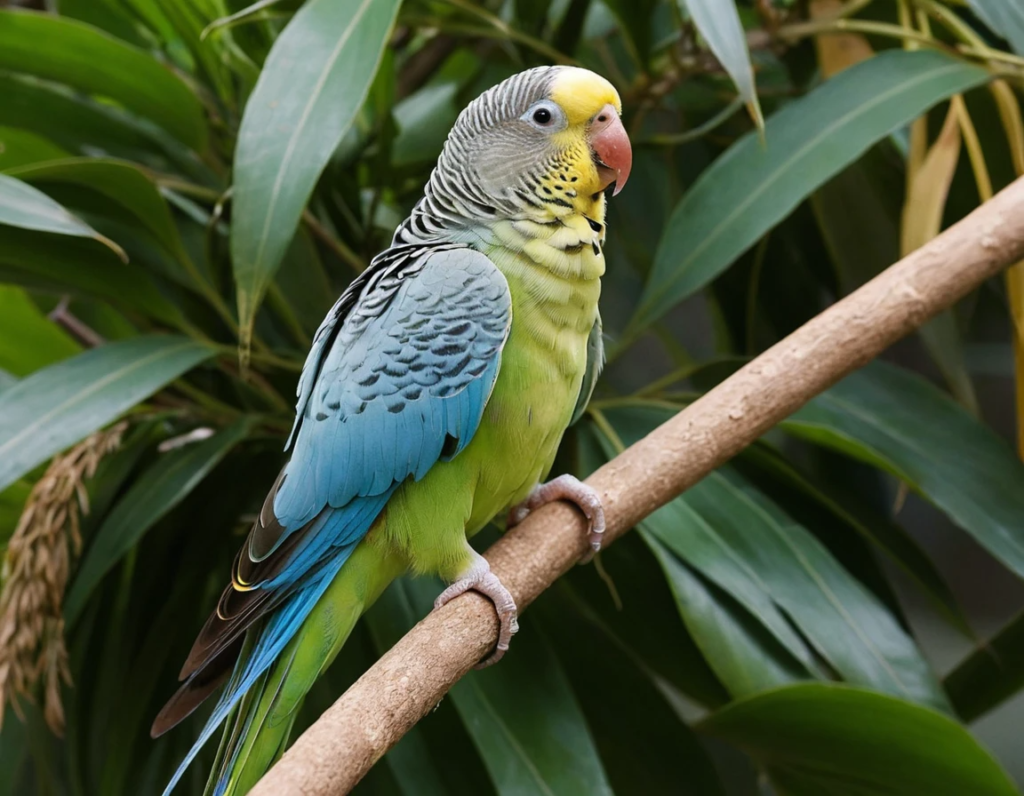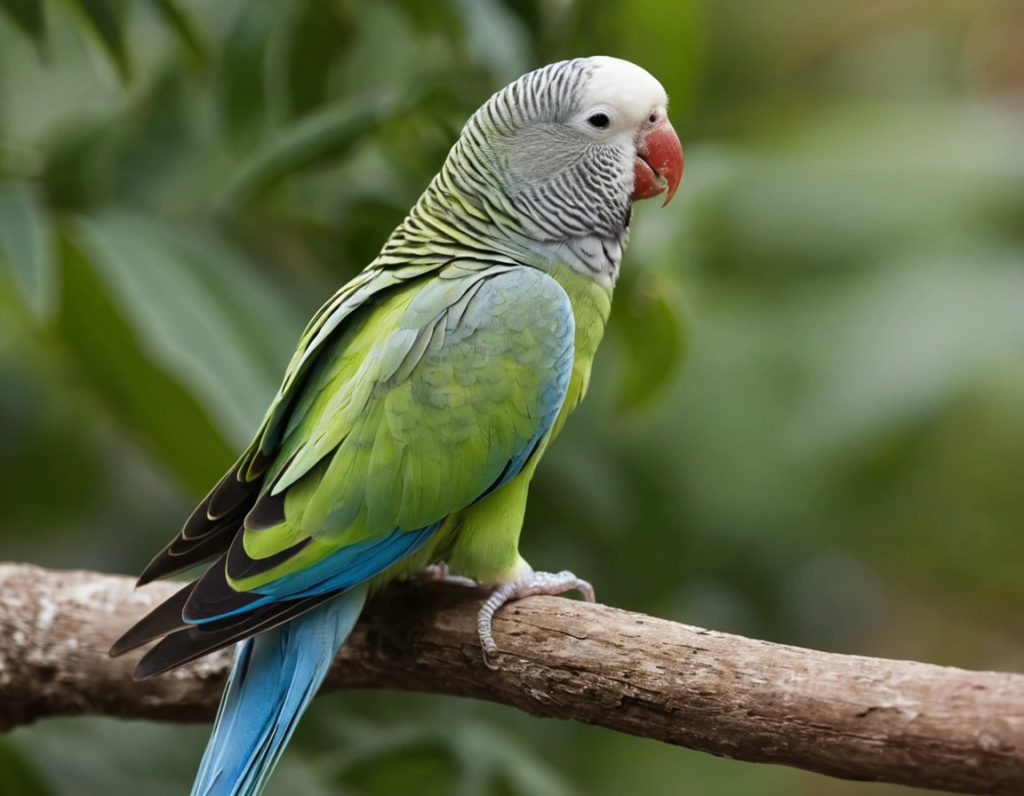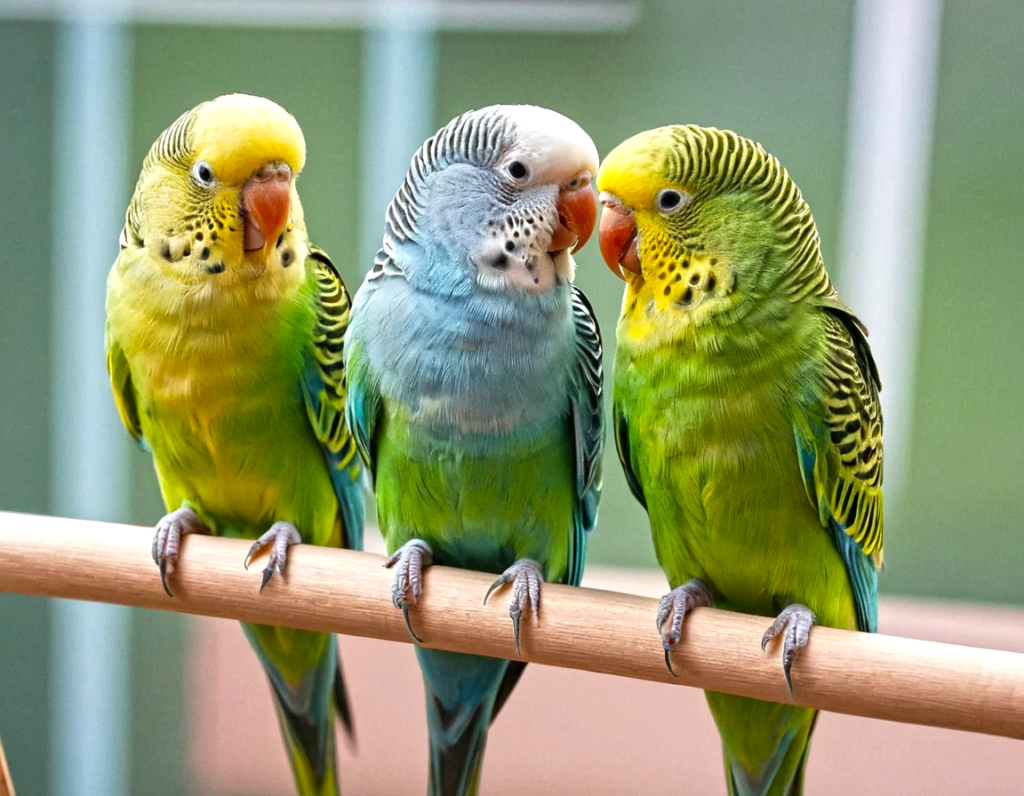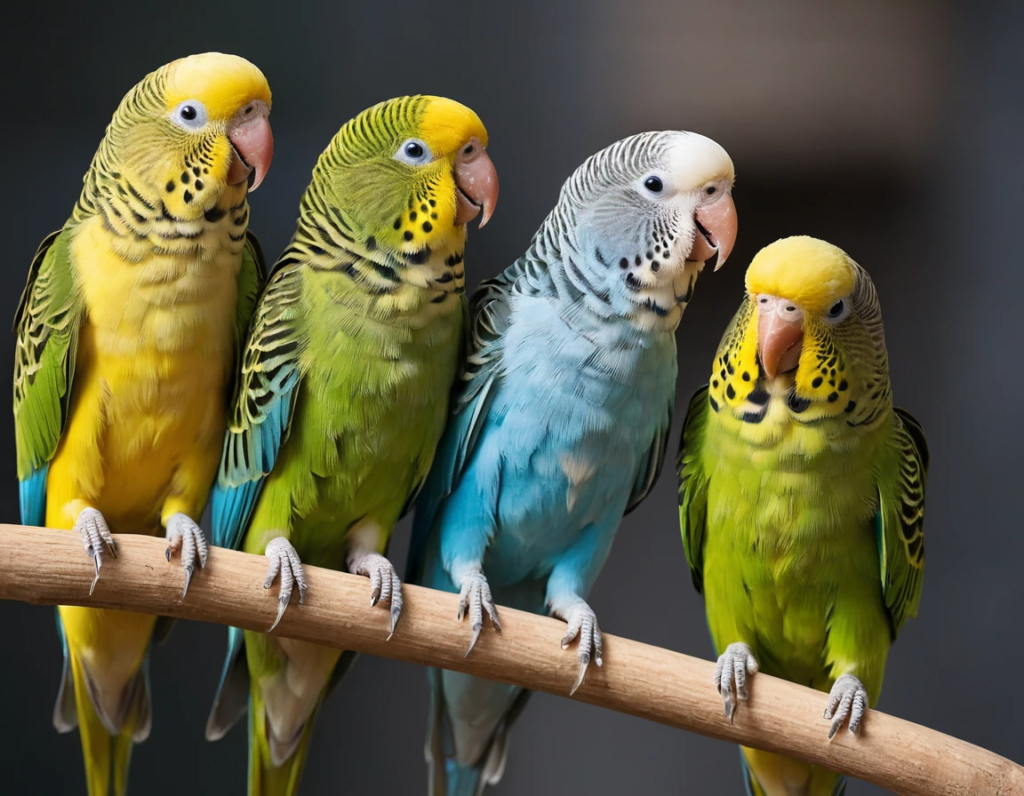
When we think of parakeets, we often picture colourful, chirpy little birds that are full of personality. These small, lively creatures have become one of the most popular pet birds worldwide. With over 100 different species of parakeets, it can be hard to know where to start if you’re looking to bring one of these feathered friends into your home. But don’t worry, whether you’re a bird newbie or a seasoned avian enthusiast, this guide will help you sort through the different parakeet types and figure out which one suits you best.
So, buckle up, because it’s time to meet some of the most popular parakeet breeds, each as unique and vibrant as the colors they sport. And, of course, there’s a bit of humor along the way because, let’s face it, parakeets can be hilarious little creatures.
1. Budgerigar: The Classic Parakeet
Let’s start with the famous budgerigar, often called a “budgie” for short. These tiny, cheerful birds are perhaps the most well-known type of parakeet and for good reason. Budgies are friendly, social, and typically easy to care for, making them a popular choice for pet owners, especially beginners. They’re usually a brilliant green with yellow, but they come in a variety of colors such as blue, white, and even a cheeky purple.
One thing that makes budgies stand out is their ability to mimic sounds and speech. In fact, some budgies can learn to talk, repeating words or phrases they hear. However, don’t expect them to start quoting Shakespeare anytime soon. You might get a “hello” or “pretty bird,” but if you’re expecting deep philosophical musings, you’re in for a surprise. Still, there’s nothing quite like hearing a budgie say “What’s up?” in its adorable little voice.
2. Indian Ringneck Parakeet: The Show-off
If budgies are the friendly neighborhood birds, then the Indian Ringneck parakeet is the show-off cousin who always wants to be the center of attention. Native to India and parts of Africa, these birds are known for their stunning appearance. With vibrant green feathers, and a distinctive black ring around their neck (hence the name), these parakeets are truly striking.
Indian Ringnecks are also quite intelligent and can learn a variety of tricks. They are known to pick up new words and phrases quickly, and some can even engage in playful conversation. Just be warned, though—if you don’t give them enough attention, they may get a little… let’s say, dramatic. Think of them as the divas of the parakeet world. When they talk, it’s often with a sense of flair that would make a Broadway star proud.
3. Monk Parakeet: The Little Builders
Monk parakeets, also known as Quaker parrots, are known for their distinctive green and gray feathers and their clever construction skills. These little birds are true architects of the avian world. In the wild, monk parakeets build large, complex nests that can house multiple families. They’re like the tiny contractors of the bird kingdom—no one gets left out!
These parakeets are friendly and playful but can be a bit noisy. They love to chatter away, and if you’re a fan of constant bird gossip, the monk parakeet might be your perfect match. However, it’s worth mentioning that monk parakeets have a reputation for being a little more independent than some of the other parakeet types. They enjoy socializing, but they also like their personal space. So, if you’re looking for a bird who’s a little less clingy, the monk parakeet might just be the right fit.
4. Alexandrine Parakeet: The Elegant One
The Alexandrine parakeet is like the bird version of royalty. With its regal green feathers, long tail, and subtle blush of pink on its cheeks, this parakeet is certainly one of the more elegant types out there. Named after Alexander the Great (who, rumor has it, took a few of these beauties back to Europe with him), these birds are not just about good looks—they’ve got brains too.
Alexandrine parakeets are known to be highly intelligent and can learn an impressive range of words and tricks. They are also extremely social and enjoy interacting with their human companions. However, don’t be fooled by their charming demeanor. These birds can be a bit stubborn and independent, so if you’re looking for a bird who follows every command to the letter, you may need to work a little harder with an Alexandrine. But with some patience, you’ll be rewarded with a bird that will surely charm your socks off.
5. Bourke’s Parakeet: The Calm and Collected
If your idea of a parakeet is one that doesn’t screech all day long and enjoys lounging around in peace, then look no further than the Bourke’s parakeet. These parakeets are calm and gentle, making them great pets for people who want a quieter bird. Their soft, muted colors of pale pink, blue, and lavender give them a peaceful, serene look, and their demeanor matches perfectly.
Bourke’s parakeets are social but not overly demanding. They’re the type of bird that enjoys hanging out with their humans but won’t make a fuss if you’re busy. This makes them an ideal choice for people who have a quieter lifestyle or live in apartments where noise might be a concern. They might not be as vocal as other parakeets, but that’s part of their charm. A Bourke’s parakeet is like the low-key, chill friend who’s always up for a snack and a good conversation—without stealing the spotlight.
6. Scarlet-chested Parakeet: The Fancy One
The scarlet-chested parakeet is like that one friend who shows up to every party looking flawless. Native to Australia, this parakeet has a stunning mix of vibrant colors—green, blue, yellow, and, of course, its signature scarlet red chest. These parakeets are as beautiful as they are rare, and they’re often considered one of the more exotic parakeet types.
Scarlet-chested parakeets are typically friendly and social but can be a little shy around strangers. They are not as well-known for talking as other species, but they make up for it with their sheer elegance and beauty. If you’re looking for a bird that will turn heads with its colorful plumage, the scarlet-chested parakeet will certainly deliver. But beware, they can be a bit like a diva—requiring the right conditions to thrive. So, make sure you’re ready to give them the special treatment they deserve.
7. Caique Parakeet: The Clown
Last but certainly not least, we have the Caique parakeet. Known for their fun-loving and clownish personalities, Caiques are small birds with big attitudes. Their bold, vibrant colors (often a mix of green, yellow, and orange) match their energetic and playful personalities. These parakeets are known to be especially active and are often described as “the clowns of the parakeet world.” They love to play, entertain, and make you laugh with their quirky antics.
Caiques are also highly social and enjoy being the center of attention. They can be a bit mischievous at times, but that’s just part of their charm. If you’ve ever wanted a parakeet that will make you giggle with its goofy behavior, the Caique is the one for you. Just be prepared for a bird that’s always up to something, whether it’s dancing, playing, or causing a bit of chaos.
The Importance of Choosing the Right Parakeet
Now that you’ve met a variety of parakeet types, it’s time to think about which one might be the best fit for your lifestyle. Each parakeet type comes with its own unique set of characteristics, so considering your preferences and living situation will help ensure a happy, healthy relationship with your feathered friend.
For instance, if you live in a bustling household with lots of activity, a playful bird like the Caique might be the perfect match. Their clownish antics and high energy will blend seamlessly into a lively environment. On the other hand, if you live in a quieter space like an apartment or prefer a calmer pet, a Bourke’s Parakeet could be just what you’re looking for. Their mellow nature and subdued chirps make them ideal for those who need a bird with a more laid-back vibe.
It’s also important to think about your commitment level. Some parakeets, like the Indian Ringneck, are known for being a little more independent and can sometimes be a bit on the stubborn side. If you’re willing to invest time and patience into training and socializing them, you’ll be rewarded with a loving and talkative companion. But if you’re looking for a bird that’s more of a “low-maintenance” pet, a Budgie or Bourke’s Parakeet may require less effort in terms of behavioral training and interaction.
Parakeet Care: A Quick Primer
Regardless of which parakeet type you choose, all parakeets need a few basic essentials to stay happy and healthy. Here are some quick care tips that apply to all parakeet species:
- Diet: Parakeets need a balanced diet consisting of high-quality pellets, seeds, fresh fruits, and vegetables. A little bit of variety will help keep them healthy and prevent boredom. But remember, not all fruits and veggies are safe for birds—avoid avocado and caffeine!
- Social Interaction: Parakeets are highly social animals and require daily interaction with their human family members (or other parakeets if you have more than one). They need mental stimulation and affection to stay emotionally healthy. But don’t expect them to be content with just hanging out in a cage all day—parakeets need playtime, exploration, and companionship.
- Cage Setup: While parakeets are small, they are very active. So, a spacious cage with plenty of perches, toys, and space to fly is crucial. A bored parakeet can become destructive or anxious, so always make sure they have enough entertainment inside their cage. Consider adding a few mirrors (but not too many, as they can be territorial) or fun puzzle toys that encourage mental stimulation.
- Grooming: Parakeets are generally very good at grooming themselves. However, you should still provide occasional assistance, especially when it comes to their nails and beaks. Most parakeets also love a good misting with water, so a gentle spray every now and then can keep their feathers in top shape.
- Health Checks: Keeping an eye on your parakeet’s health is important. Look for signs of illness like changes in eating habits, droopy wings, or odd behavior. If something seems off, it’s always best to consult with an avian vet. After all, a healthy parakeet is a happy parakeet!

Funny Parakeet Moments to Look Forward To
As if the joy of having a parakeet in your life wasn’t enough, these little guys also bring endless entertainment to your home. From their adorable chirps to their spontaneous dance moves, parakeets have a knack for making us laugh. Here are a few funny things you might witness with your new bird:
- Dance Party: Parakeets are surprisingly good dancers. They may bob their heads, shake their bodies, or flap their wings in response to music. If you’re lucky, you might catch them performing their own version of the “Macarena.” Just don’t expect them to perform on command—it’s a diva thing.
- Mirror Confusion: Parakeets are often fascinated by mirrors. If you put one inside their cage, you may notice them getting into long, heated “conversations” with their reflection. It’s as if they think they’ve met a long-lost twin. Who needs Netflix when you have your parakeet’s drama-filled life to enjoy?
- Random Talking: Parakeets are talkative little birds, but their timing can be hilariously random. One moment, they’re quietly perched, minding their own business, and the next, they’ll blurt out something like “Hello!” or “Pretty bird!” at the most unexpected times. You’ll never know when your bird is going to start channeling its inner stand-up comedian.
- The Sudden Sneeze: Sometimes, parakeets sneeze in the cutest way possible, especially when they’re flapping their wings or perched on your shoulder. It’s like they’re trying to get your attention, saying, “Hey, I just sneezed, and it was adorable, didn’t you think?”
- Playtime Chaos: Parakeets are masters of chaos when it comes to playtime. They’ll dive into toys, climb all over the place, and knock things over just for the fun of it. And no matter how many times they end up making a mess, you’ll still find yourself laughing at their antics. It’s a bit like living with a toddler who never grows up.
Conclusion: Picking Your Parakeet
Choosing the right parakeet type is all about matching their personality and needs with yours. Whether you’re looking for a talkative companion, a calm, quiet friend, or a colorful entertainer, there’s a parakeet for everyone. And while these feathered pals come in many different colors, sizes, and personalities, one thing is for sure—they’re guaranteed to bring joy and laughter to your life.
So, take your time, do your research, and remember that no matter which parakeet you choose, you’ll be gaining a loyal and loving companion. And who knows, maybe one day you’ll even hear your budgie say “I’m the best bird in town!” (It’s a confidence thing, trust us).
Wrapping It Up
With all these different types of parakeets to choose from, it’s clear that there’s no shortage of variety when it comes to these playful, colorful birds. Whether you want a talkative companion, a showy diva, or a laid-back friend, the perfect parakeet is out there waiting for you.
So, take your time, enjoy the process, and remember that a parakeet is not just a pet; it’s a tiny, chirpy little companion who will bring lots of laughs, love, and feathered fun into your life. Just be prepared for the occasional squeak, squawk, or dance party—you’ll never quite know what your parakeet is up to next. But whatever it is, you can be sure it will be full of character. And that’s why we love them so much!
Frequently Asked Questions (FAQs) on Parakeet Types
1. What is the most common type of parakeet?
Answer: The most common type of parakeet is the Budgerigar, also known as a “budgie.” Budgies are small, colorful, and friendly birds that are often found in homes as pets due to their gentle nature and ability to mimic sounds and speech.
2. Do different types of parakeets have different personalities?
Answer:Yes! Each type of parakeet has its own unique personality traits. For example:
- Budgies are playful and social, often enjoying human interaction.
- Indian Ringnecks can be a bit more independent and sometimes stubborn but are also very intelligent and capable of learning tricks.
- Caiques are energetic and mischievous, making them the class clowns of the parakeet world.
- Bourke’s Parakeets are calm and gentle, preferring a quieter lifestyle.
3. Can parakeets talk?
Answer: Yes, some parakeets can learn to talk, especially species like the Budgerigar, Indian Ringneck, and Caique. Budgies are particularly good at mimicking words and phrases, although not all parakeets are inclined to talk. However, even if they don’t speak, parakeets will often “chatter” or mimic sounds, which can be just as entertaining!
4. Which type of parakeet is best for beginners?
Answer: For beginners, the Budgerigar is often the best choice. Budgies are small, friendly, and easy to care for. They’re also social and can adapt well to living in smaller spaces, like apartments. If you’re looking for a low-maintenance pet to start with, a Budgie might be the perfect pick.
5. How do I know which parakeet type will fit my lifestyle?
Answer: Consider your environment and how much time you can spend with your bird. For instance:
- Active, playful environments: Choose energetic birds like Caiques or Indian Ringnecks.
- Quiet, calm environments: Opt for more laid-back species like Bourke’s Parakeet.
- Talkative birds: If you want a bird that might learn to talk, Budgies and Indian Ringnecks are great options.
6. Are there any parakeet types that are particularly noisy?
Answer: Yes, some parakeets can be noisier than others. For example, Indian Ringnecks and Monk Parakeets can be quite vocal, especially if they’re not getting enough attention. Caiques are also known for being loud during their playtime, while Bourke’s Parakeets are relatively quiet.
7. Can different parakeet types live together in the same cage?
Answer: While some parakeets can live together peacefully, it’s important to be cautious. Birds of different types and sizes may not always get along, and introducing new birds to a cage can sometimes lead to territorial behavior. It’s always a good idea to introduce them gradually and monitor their interactions. Some species, like Budgies, often get along with others, but a Monk Parakeet or Indian Ringneck may prefer being the only bird in the cage.
8. Which parakeet type is the most colourful?
Answer: Indian Ringnecks and Scarlet-chested Parakeets are among the most colorful. Indian Ringnecks have bright green feathers and a distinctive ring around their neck, while Scarlet-chested Parakeets showcase a stunning combination of red, green, and blue feathers. However, all parakeet species come in a variety of colors, so you can find colorful options across the board.
9. Are parakeet types easy to train?
Answer: Parakeets are intelligent and can be trained, but their ease of training depends on the species and individual bird. Budgies and Indian Ringnecks tend to be relatively easy to train and can learn tricks or speech, while Caiques and Monk Parakeets might be a bit more independent or stubborn, making training slightly more challenging.
10. How long do different types of parakeets live?
Answer: The lifespan of parakeets can vary depending on their species and the care they receive:
- Budgies typically live around 5 to 10 years, although some can live longer with proper care.
- Indian Ringnecks and Alexandrine Parakeets can live anywhere from 15 to 30 years in captivity.
- Monk Parakeets have a lifespan of 10 to 25 years.
- Caiques live between 15 and 20 years on average.
11. What type of parakeet is the most playful?
Answer: Caiques are often considered the most playful and energetic. They’re known for their goofy antics and will keep you entertained for hours. If you’re looking for a bird that loves to play and engage in fun activities, a Caique might be the perfect choice.
12. Are there any parakeet types that require more care or attention than others?
Answer: Yes, some parakeet types do require more attention or care than others. For instance, Indian Ringnecks and Monk Parakeets can be more demanding in terms of socialization and mental stimulation. They might need more training and interaction to prevent boredom and behavioral issues. On the other hand, Bourke’s Parakeets are generally more low-maintenance and easier to care for.
13. Can parakeets live outside?
Answer: Parakeets can live outside in warm climates, but only if they are in a secure, enclosed aviary and the weather is consistently mild. It’s important to ensure that the aviary is protected from predators and extreme weather conditions. In most cases, parakeets are happier living indoors where they’re safe from temperature extremes and potential dangers.
14. Do all parakeet types need a companion?
Answer: While parakeets are social birds, not all of them require a companion to thrive. Species like Bourke’s Parakeets can be perfectly content as a solo bird, while others, such as Budgies and Caiques, tend to do better with a companion. However, if you’re considering getting two birds, make sure to introduce them properly to avoid territorial issues.
15. How much does it cost to adopt a parakeet?
Answer: The cost of adopting or purchasing a parakeet can vary greatly depending on the species, age, and where you get the bird from. On average, a Budgie might cost anywhere from $10 to $30, while more exotic species like the Indian Ringneck or Alexandrine Parakeet may range from $100 to $500. The cost of care, including cages, food, toys, and medical expenses, should also be factored in when considering a parakeet as a pet.


